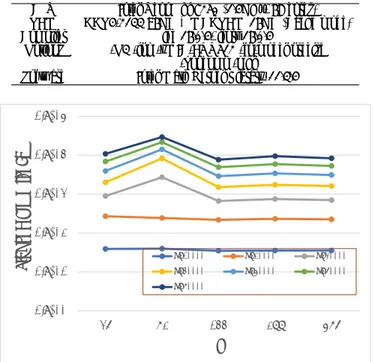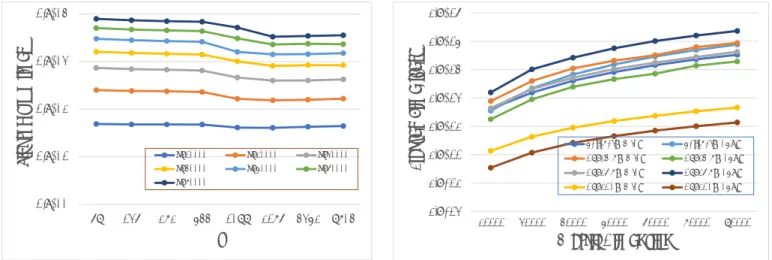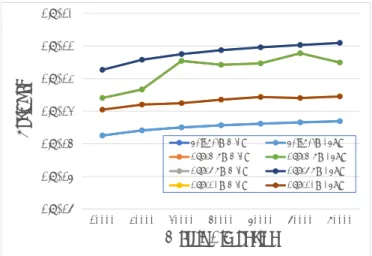Performance Evaluation of a Combination of the Parallel Bisection Method and the Block Inverse Iteration Method with Reorthogonalization for Eigenvalue Problems on MIC processor
全文
(2) IPSJ SIG Technical Report. Vol.2017-MPS-114 No.9 2017/7/17. 2.1 Implementation of the Bisection Method Herein, we discuss the implementation of the bisection method for real symmetric tridiagonal matrices. The bisection method is an algorithm for computing the eigenvalues of a real symmetric matrix using binary search. It is proposed in [1], and its implementation for ordinary CPU is provided by the DSTEBZ routine of LAPACK (Linear Algebra PACKage) [4]. We adopt the implementation introduced in [8] as a thread parallel bisection method suitable for shared memory systems such as MIC environments.. 2.2 Implementation of the Inverse Iteration Method Herein, we briefly present the block inverse iteration method with reorthogonalization [5]–[8] for the eigenvector problem. For an n × n real symmetric tridiagonal matrix T , let λi ∈ R(λ1 < · · · < λn ) be its eigenvalues and qi ∈ R be ˜ i is the approximate the eigenvectors corresponding to λi . If λ (0) value of λi , and the initial vector vi is randomly (uniformly) (j) generated, then the vector vi converges to the eigenvector qi as j → ∞ in the following linear iterative equation ˜ i I)v (j) = v (j−1) , j = 1, 2, . . . , (T − λ i i. (1). where I is the n × n identity matrix. The inverse iteration method [5]–[7] is based on the above procedure. The complexity of this method for obtaining m(< n) eigenvectors is (j) O(mn). Practically, the vector vi must be normalized at each iteration to avoid overflow and underflow. The obtained eigenvectors are orthogonal if the eigenvalues of T are sufficiently separated. By contrast, it is known that the eigenvectors may fail to be orthogonal if the eigenvalues of T are clustered. In this case, it is proposed that eigenvectors corresponding to clustered eigenvalues should be reorthogonalized. We adopt the block inverse iteration method with reorthogonalization proposed in [8] as the implementation of the inverse iteration method for MIC environment. This is a modification of the simultaneous inverse iteration method. The dominant part of the block inverse iteration method could be implemented, with efficient execution of matrix multiplications, on SSE and AVX enabled processors.. 3. Performance Evaluation We present the results of the numerical experiments that were conducted to evaluate the performance of the eigensolver using the parallel bisection method (PBi) and the block inverse iteration method with reorthogonalization (BIR). Specification of CPU and MIC environments are shown in Tables 1 and 2, respectively. Test matrix for the evaluation is n×n symmetric tridiagonal matrices T , random matrix with uniformly distributed random numbers di , ei ∈ [0, 1]. ⓒ 2017 Information Processing Society of Japan. Table 1: Specification of the experimental environment (CPU) CPU RAM Compiler Options Software. Intel Xeon E5-2695 v4 x2 (2.10GHz, 18 cores x2) DDR4-2400 128GB icc 16.0.4, ifort 16.0.4 -O3 -ipo -xCORE-AVX2 -fp-model precise -qopenmp -mkl Intel Math Kernel Library 11.3.4. Table 2: Specification of the experimental environment (MIC) CPU RAM Compiler Options Software. Intel Xeon Phi 7250 (1.4GHz, 68 cores) DDR4-2133 96GB + MCDRAM 16GB (Cache mode) icc 16.0.4, ifort 16.0.4 -O3 -ipo -xMIC-AVX512 -fp-model precise -qopenmp -mkl Intel Math Kernel Library 11.3.4. 1.E+05. Elapsed Time [sec]. transformation of the previous band transformation. In this section, we briefly present the latter procedure of obtaining eigenpairs of symmetric tridiagonal matrix.. 1.E+04 1.E+03 1.E+02. 1.E+01. n=10000. n=20000. n=30000. n=40000. n=50000. n=60000. n=70000. 1.E+00 36. 72. 144. 288. 576. r Fig. 1: Computation time for each block size (CPU, T ). 3.1 Determining the Optimal Block Size for the Eigensolver We first determine the optimal block size for the BIR algorithm. To this end, we use the following search method. 1) Set the initial block size r to the number of processor cores of each experimental environment. 2) Measure the computation time for obtaining all eigenvalues and eigenvectors of T . 3) If the computation time is longer than that of previous two trials, stop searching and let the block size giving minimum computation time be optimal. 4) Otherwise, set the block size r := 2 × r and continue searching. Figures 1 and 2 show the computation time for T using the block inverse iteration method with reorthogonalization for different block sizes r on CPU and MIC environments for the matrix T of size n. It should be noted that all graphs are logarithmic. We optimize the parameter for the BIR algorithm, since it was more than 100 times slower than the PBi algorithm. In addition, if we use hyper-threading technology, the PBi algorithm becomes faster, whereas the BIR algorithm becomes slower. Thus, hyper-threading technology is not adopted. 2.
(3) IPSJ SIG Technical Report. Vol.2017-MPS-114 No.9 2017/7/17 1.E+05. 1.E+04. 1.E+03. 1.E+02. 1.E+01. n=10000. n=20000. n=30000. n=40000. n=50000. n=60000. Elapsed Time [sec]. Elapsed Time [sec]. 1.E+04. 1.E+00. 136. 272. 1.E+02. 1.E+01 1.E+00. 1.E-01. n=70000. 68. 1.E+03. 544. 1088. 2176. 4352. 1.E-02. 8704. 10000. 20000. r. PBi+RBI(MIC). PBi+RBI(CPU). DSTEMR(MIC). DSTEMR(CPU). DSTEQR(MIC). DSTEQR(CPU). DSTEDC(MIC). DSTEDC(CPU). 30000. 40000. 50000. 60000. 70000. Matrix Dimension. Fig. 2: Computation time for each block size (MIC, T ). Fig. 3: Computation time for T 1.E-10. These graphs show that block size r = 144 for CPU environment and r = 2176 for MIC yield the best performance.. We compare the execution time for obtaining all eigenvalues and eigenvectors of the matrix T using the PBi+BIR algorithm with the corresponding time for the MRRR algorithm. For further comparison, we add the QR [9] and Divide and Conquer algorithms [10], which are well-known methods. Because QR algorithm [9] and Divide and Conquer algorithm [10] are not able to compute partial eigenvalue and eigenvectors of target matrix. The implementations of these three algorithms are provided in Intel Math Kernel Library (MKL) [3]. In these experiments, we use DSTEMR, DSTEQR, and DSTEDC LAPACK routines provided by Intel MKL as the parallel implementations of the MRRR, QR, and Divide and Conquer algorithms, respectively. We note that the number of threads in all numerical experiments is set to be the number of processor cores. Figure 3 shows the execution time for obtaining all eigenvalues and eigenvectors using each algorithm for T (n = 10000, . . . , 70000). It should be noted that the graph is semilogarithmic. The Divide and Conquer algorithm is the fastest. However, it cannot be adopted for partial eigenvalue and eigenvectors of the target matrix. PBi+BIR achieves higher performance than MRRR in MIC environment, as the graph shows. Moreover, evaluations for accuracy are performed. Figure 4 shows the orthogonality kQ| Q − IkF of eigenvectors obtained by each eigensolver for T , respectively (with n = 10000, . . . , 70000). n denotes the dimension of the target ˜1, . . . , λ ˜ n }, and Q = [q1 · · · qn ]. The matrix, D = diag{λ graphs are semilogarithmic. The lines of PBi+BIR (MIC), DSTEMR(MIC), DSTEQR(MIC) and DSTEDC (MIC) are hidden behind the corresponding lines in CPU environment, since the results are nearly equal. The orthogonality among the eigenvectors obtained by the PBi+BIR algorithm is significantly smaller than that obtained by the other algorithms. ⓒ 2017 Information Processing Society of Japan. Orthogonality. 3.2 Comparison with Other Algorithms. 1.E-11 1.E-12 1.E-13. 1.E-14 1.E-15 1.E-16. 10000. 20000. PBi+RBI(MIC). PBi+RBI(CPU). DSTEMR(MIC). DSTEMR(CPU). DSTEQR(MIC). DSTEQR(CPU). DSTEDC(MIC). DSTEDC(CPU). 30000. 40000. 50000. 60000. 70000. Matrix Dimension Fig. 4: Orthogonality of obtained eigenvectors for T1. Figure 5 shows the results of the evaluation of decomposition accuracy, namely, the residuals kT Q − QDkF of the decomposed eigenvalues and eigenvectors for T , respectively. PBi+BIR achieves higher accuracy than MRRR in terms of decomposition. In conclusion, in terms of both speed and accuracy, the PBi+BIR algorithm is superior to the MRRR algorithm in MIC environment. The high accuracy of PBi+BIR may be attributed to the high relative accuracy of the PBi algorithm.. 4. Conclusion We evaluated the performance of an eigensolver using a combination of the parallel bisection method and the block inverse iteration method with reorthogonalization (PBi+BIRalgorithm) for computing all eigenpairs of a real symmetric tridiagonal matrix. In particular, we compared the performance of PBi+BIR with that of MRRR, which can be adopted for obtaining a subset of eigenpairs. From the preliminary experiments, we determined the optimal block size for the block inverse iteration method with reorthogonalization. We measured the computation time of PBi+BIR, for each block 3.
(4) IPSJ SIG Technical Report. Vol.2017-MPS-114 No.9 2017/7/17. 1.E-10 1.E-11. Residual. 1.E-12 1.E-13 1.E-14 1.E-15. 1.E-16. 10000. 20000. PBi+RBI(MIC). PBi+RBI(CPU). DSTEMR(MIC). DSTEMR(CPU). DSTEQR(MIC). DSTEQR(CPU). DSTEDC(MIC). DSTEDC(CPU). 30000. 40000. 50000. 60000. 70000. Matrix Dimension Fig. 5: Residuals of decomposition for T. [4] E. Anderson, Z. Bai, C. Bischof, L. S. Blackford, J. W. Demmel, J. Dongarra, J. Du Croz, S. Hammarling, A. Greenbaum, A. McKenney, and D. Sorensen, LAPACK Users Guide (Third ed.). Philadelphia, PA, USA: SIAM, 1999. [5] G. H. Golub and C. F. van Loan, Matrix Computations. Baltimore, MD, USA: Johns Hopkins University Press, 1996. [6] J. W. Demmel, Applied Numerical Linear Algebra. Philadelphia, PA, USA: SIAM, 1997. [7] B. N. Parlett, The Symmetric Eigenvalue Problem. Philadelphia, PA, USA: SIAM, 1998. [8] H. Ishigami, K. Kimura, Y. Nakamura, “A New Parallel Symmetric Tridiagonal Eigensolver Based on Bisection and Inverse Iteration Algorithms for Shared-memory Multi-core Processors”, 2015 10th International Conference on P2P, Parallel, Grid, Cloud and Internet Computing (3PGCIC), pp. 216–213, 2015. [9] W. Kahan, “Accurate eigenvalues of a symmetric tridiagonal matrix”, Technical Report, Computer Science Dept. Stanford University, no. CS41, 1966. [10] M. Gu and S. C. Eisenstat, “A divide-and-conquer algorithm for the symmetric tridiagonal eigenproblem”, SIAM J. Matrix Anal. Appl., vol. 16, no. 1, pp. 172–191, 1995.. of size r = 2m ×C, where C is the number of processor cores, and let the block size yielding the minimum computation time be the optimal. For T1 , PBi+BIR with the optimal block size parameter obtains the eigenpairs faster than MRRR in MIC environment. This is true for T2 as well, with the condition that size of the target matrix is n ≥ 60000. In addition, PBi+BIR is the only algorithm computing eigenpairs faster in MIC environment than in CPU environment. It is conceivable the AVX512 instruction set contributes to the superior performance of PBi+BIR in MIC environment, as this algorithm involves a large number of matrix multiplications. This suggests that PBi+BIR is suitable for MIC environment. Moreover, in a comparison of orthogonality of eigenvectors and residuals of eigenpairs, PBi+BIR achieves higher accuracy than MRRR, and there is no trade-off between computation speed and accuracy in MIC environment. There are many applications of eigensolvers for real symmetric matrices such as kernel principal component analysis, which frequently appears in the industrial field. Fast and accurate eigensolvers are in great demand in this field, and PBi+BIR in MIC environment may be the eigensolver of choice. In future work, we would perform a more detailed examination of the relation between computation time and block size, and establish a method for auto-tuning of the algorithm in MIC environment.. Acknowledgment This work was supported by JSPS KAKENHI Grant Number 17H02858.. References [1] J. Wilkinson, “Calculation of the eigenvalues of a symmetric tridiagonal matrix by the method of bisection”, Numer. Math., vol. 4, no. 1, pp. 362 367, 1962. [2] I. S. Dhillon, B. N. Parlett, and C. V¨omel, “The design and implementation of the MRRR algorithm”, ACM Trans. Math. Softw., vol. 32, no. 4, pp. 533–560, 2006. [3] Intel Math Kernel Library, “Available electronically at https://software.intel.com/en-us/intel-mkl/.”. ⓒ 2017 Information Processing Society of Japan. 4.
(5)
図



関連したドキュメント
Comparing the Gauss-Jordan-based algorithm and the algorithm presented in [5], which is based on the LU factorization of the Laplacian matrix, we note that despite the fact that
Keywords: Convex order ; Fréchet distribution ; Median ; Mittag-Leffler distribution ; Mittag- Leffler function ; Stable distribution ; Stochastic order.. AMS MSC 2010: Primary 60E05
In summary, based on the performance of the APBBi methods and Lin’s method on the four types of randomly generated NMF problems using the aforementioned stopping criteria, we
This paper is devoted to the study of maximum principles holding for some nonlocal diffusion operators defined in (half-) bounded domains and its applications to obtain
To address the problem of slow convergence caused by the reduced spectral gap of σ 1 2 in the Lanczos algorithm, we apply the inverse-free preconditioned Krylov subspace
Inside this class, we identify a new subclass of Liouvillian integrable systems, under suitable conditions such Liouvillian integrable systems can have at most one limit cycle, and
For a given complex square matrix A, we develop, implement and test a fast geometric algorithm to find a unit vector that generates a given point in the complex plane if this point
To derive a weak formulation of (1.1)–(1.8), we first assume that the functions v, p, θ and c are a classical solution of our problem. 33]) and substitute the Neumann boundary